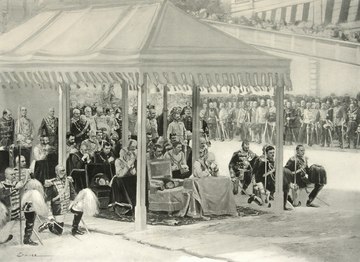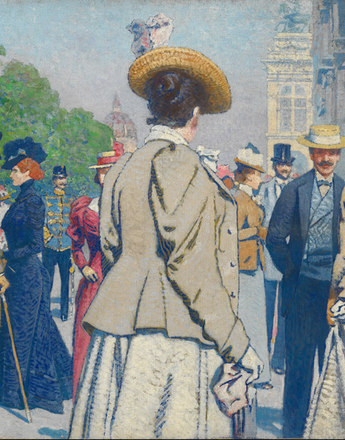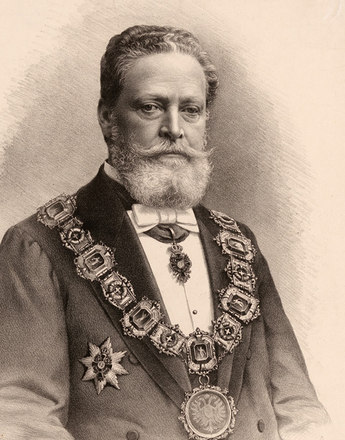The alliance between throne and altar: The Catholic Church
With the December Constitution of 1867 at the very latest, the principles of freedom of religion and conscience were firmly enshrined in law, putting an end to the last remnants of practices that had put non-Catholics at a disadvantage. Nevertheless, Catholicism was still de facto the established religion of the state.
The close interpenetration of the Catholic Church and the Austrian state resulted in a form of ‘state Catholicism’ that was to some extent part of the legacy of Joseph II, who had made the Church an organ of the state under bureaucratic supervision. In the era of neo-absolutism from 1848, however, the Church was given back its independence and granted considerable influence over family law and education. The Habsburg dynasty believed that a strengthened Church would enable it to put up a more effective stand against liberalism and nationalism. The Church saw itself as a supra-national, integrative force – as a force for cohesion offering alternative ideals to those espoused by the nationalists and proponents of the class struggle.
This symbiosis between the Habsburg dynasty and the Catholic Church had an historical background, as throne and altar had been inseparably allied ever since the religious conflicts of the sixteenth and seventeenth centuries. The dynasty put itself at the service of the Catholic cause – and in return the Church made the principle of monarchy a permanent fixture in the sacred sphere.
Even the Liberalism that gained the upper hand from the 1860s was powerless to endanger the dominant position of the Church, upon which it could at the very most only impose certain external restrictions. The higher levels of the civil service, for example, were still in practice only accessible to Catholics.
Several factors underpinned the privileged position of the Church. Firstly the episcopacy and religious foundations were great landowners and thus economically independent of the state. For centuries the higher ecclesiastical dignitaries had enjoyed special rights as a result of their standing. Bishops and abbots had seats in the provincial diets and the most important Catholic dignitaries sat in the upper house of the Reichsrat.
In addition the Church was an influential power in society generally. For most people the parish priest was a figure of great authority, exercising ‘command over souls’. Even as late as around 1900 religion was a formative power, especially in the country, and influenced everyday life to a far greater extent than is the case today. The religious rituals accompanied Catholics from the cradle to the grave and gave their lives a sense of purpose and meaning. The close symbiosis between popular religion and folk customs meant that the lives of the broad mass of the population were strongly marked by the Catholic faith, which also provided them with a structure for social life. This of course applied not only to the Catholic Church but also to the other Christian confessions and religious faiths represented in the Monarchy. However, because the Roman Catholic Church was the ‘Church of state’, it had a greater visible presence than the other religious institutions.
Even the Church, however, had to face up to the upheavals taking place in society and seek new ways and means of adapting to the growth of democracy. As the Catholic Church had its own bodies with responsibility for the press and for associations and societies, it was in a position to exert great influence upon public opinion. It also found a mouthpiece for its concerns – and an ally in the Reichsrat – in the form of the Christian Social Party. The Church could still mobilize enormous support when it wished to. The impressive rallies of the 23rd International Eucharistic Congress in Vienna in 1912, for example, culminated in a procession around the Ring and festive open-air mass on Heldenplatz with no fewer than 150,000 participants.
Not everyone, however, was prepared to accept that the Church should wield such power. Both the Liberal and the Socialist movements made anti-clericalism part of their programme, as did many nationalist groupings, with not only the German nationalists but also the liberal-nationalist Czech parties pinning the militant slogan ‘Away from Rome!’ firmly to their colours. However, in spite of the criticism of the Church’s power the numbers of those who actually left it remained relatively low, though there was a marked increase in the number of nominal Christians in the towns. This phenomenon was particularly marked in Bohemia, which was torn apart by German-Czech antagonism and was famous for the phenomenon of Catholic practices effectively becoming little more than folk customs.
Translation: Peter John Nicholson
Hanisch, Ernst: Der lange Schatten des Staates. Österreichische Gesellschaftsgeschichte im 20. Jahrhundert [Österreichische Geschichte 1890–1990, hrsg. von Herwig Wolfram], Wien 2005
Křen, Jan: Dvě století střední Evropy [Zwei Jahrhunderte Mitteleuropas], Praha 2005
Liebmann, Maximilian: „Von der Dominanz der katholischen Kirche zu freien Kirchen im freien Staat – vom Wiener Kongreß 1815 bis zur Gegenwart“, in: Wolfram, Herwig (Hrsg): Geschichte des Christentums in Österreich. Von der Spätantike bis zur Gegenwart, Wien 2005, 361–456
Rumpler, Helmut: Eine Chance für Mitteleuropa. Bürgerliche Emanzipation und Staatsverfall in der Habsburgermonarchie [Österreichische Geschichte 1804–1914, hrsg. von Herwig Wolfram], Wien 2005
Traum und Wirklichkeit. Wien 1870–1930. Katalog der 93. Sonderausstellung des Historischen Museums der Stadt Wien 1985, Wien 1985
Wandruszka, Adam (Hrsg.): Die Habsburgermonarchie 1848–1918, Band IV: Die Konfessionen, Wien 1985
Das Zeitalter Kaiser Franz Josephs – 2. Teil: 1880–1916. Glanz und Elend. Katalog der Niederösterreichischen Landesausstellung auf Schloss Grafenegg 1987, Wien 1987



